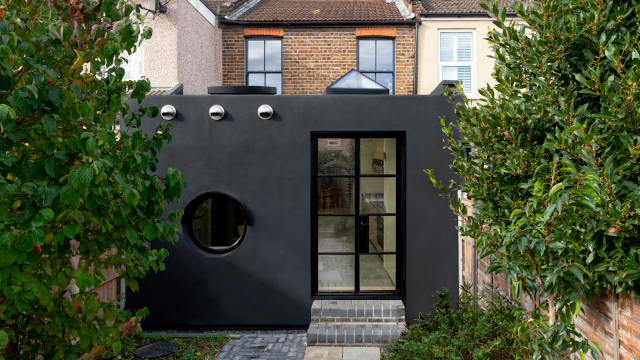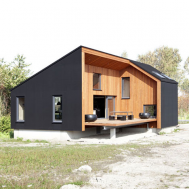In recent years, an exciting new application for spray-on-rubber and black EPDM foil has emerged. Their uses? Home facades! Since 2019, a small handful of (sleek and stylish) rubber-exterior houses have popped up across England and the Netherlands. Have you ever seen anything like them before? We sure hadn’t – but we’d love to see more! Check out these ultra-contemporary homes down below.
In London

A London couple wanted to construct a totally unique addition to their late-1800’s property. They approached their local architecture office, Office S&M, for help with the new extension. The addition’s facade isn’t just modern by historic house standards, but even compared to the most contemporary of homes. While many contemporary builds favor clapboard, brick, or stucco exteriors, this addition’s facade is coated in spray-on-rubber.
Prokol, the material coating the couple’s addition, has gone mostly unnoticed by the residential construction community – not a surprise since it was developed to coat oil rigs. While other builds have used sheet rubber, none had the seamless finish of the spray-on material. In addition to the sleek look, the clients were pleased with the overall cost of the project which came in at £4,000, or about $5,000 USD.
So, how does one install the Prokol? The rubber material is held in a van-size tanker, where it is pressurized and kept at a high temperature. The material is then fed through a hose by the equipment operator. Because it is a two-part epoxy, the separate parts are mixed together in a specialized spray nozzle, where they emerge as hot, high-pressure droplets. As soon as they hit the application surface, they cool instantly.
As for upkeep, the finish requires no care. Since Prokol was designed for use on commercial boats, it is made to withstand far more wear and tear than a residential home’s exterior will ever face. Additionally, the material is UV-stable, waterproof, and guaranteed to last 30 years.
In the Netherlands

Another rubber house (fittingly named “RUBBERHOUSE”) was constructed in the experimental housing area of De Eenvoud, outside the city of Almere in the Netherlands. Coated in durable black rubber for protection against the elements, all of the materials used for the project were prefabricated for easy assembly – hence the total construction of the house took just three months.
An experimental construction, the single family home was built using energy efficient, sustainable cross-laminated timber and a black EPDM rubber skin. The external skin, black EPDM foil, is commonly used as a single ply membrane for flat roofs. The material is meant to generate an immaterial and rough aesthetic, one which stands in stark contrast to the cut out forming the building’s wooden terrace.
The De Eenvoud project is a follow-up settlement to the experimental housing settlements De Fantasie and De Realiteit which were developed in the 1980’s and stand in a long tradition of experimental, free, and self-determined building. Originally these projects were developed to promote the model of privately financed housing in the Netherlands.
Would you use rubber in the construction of your home? Tweet us about it @applerubber.
